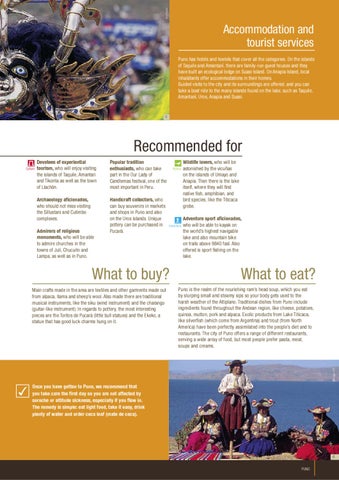M. d’Auriol
Accommodation and tourist services Puno has hotels and hostels that cover all the categories. On the islands of Taquile and Amantaní, there are family-run guest houses and they have built an ecological lodge on Suasi Island. On Anapia Island, local inhabitants offer accommodations in their homes. Guided visits to the city and its surroundings are offered, and you can take a boat ride to the many islands found on the lake, such as Taquile, Amantaní, Uros, Anapia and Suasi.
c.
Recommended for Devotees of experiential tourism, who will enjoy visiting the islands of Taquile, Amantari and Tikonta as well as the town of Llachón.
Culture
Archaeology aficionados, who should not miss visiting the Sillustani and Cutimbo complexes. Admirers of religious monuments, who will be able to admire churches in the towns of Juli, Chucuito and Lampa, as well as in Puno.
Popular tradition enthusiasts, who can take part in the Our Lady of Candlemas festival, one of the most important in Peru. Handicraft collectors, who can buy souvenirs in markets and shops in Puno and also on the Uros islands. Unique pottery can be purchased in Pucará.
Wildlife lovers, who will be astonished by the vicuñas on the islands of Umayo and Anapia. Then there is the lake itself, where they will find native fish, amphibian, and bird species, like the Titicaca grebe.
Nature
What to buy?
What to eat? Puno is the realm of the nourishing ram’s head soup, which you eat by slurping small and steamy sips so your body gets used to the harsh weather of the Altiplano. Traditional dishes from Puno include ingredients found throughout the Andean region, like cheese, potatoes, quinoa, mutton, pork and alpaca. Exotic products from Lake Titicaca, like silverfish (which come from Argentina) and trout (from North America) have been perfectly assimilated into the people’s diet and to restaurants. The city of Puno offers a range of different restaurants, serving a wide array of food, but most people prefer pasta, meat, soups and creams.
W. Hupiu / PP
Main crafts made in the area are textiles and other garments made out from alpaca, llama and sheep’s wool. Also made there are traditional musical instruments, like the siku (wind instrument) and the charango (guitar-like instrument). In regards to pottery, the most interesting pieces are the Toritos de Pucará (little bull statues) and the Ekeko, a statue that has good luck charms hung on it.
Adventure sport aficionados, who will be able to kayak on the world’s highest navigable lake and also mountain bike on trails above 9840 fasl. Also offered is sport fishing on the lake.
Adventure
Once you have gotten to Puno, we recommend that you take care the first day so you are not affected by soroche or altitude sickness, especially if you flew in. The remedy is simple: eat light food, take it easy, drink plenty of water and order coca leaf (mate de coca).
d. PUNO
